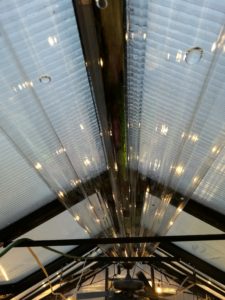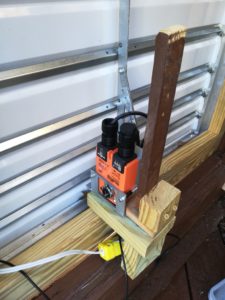Since I use my ACF GrowMore greenhouse more as an add-on conservatory to the house than a separate greenhouse, growing only space, I am not fond of condensation forming at the roof of the greenhouse and dripping back down. It happens mostly straight down the center of the greenhouse at the peak where there isn’t an easy way for the drops to roll down the roof. Trust 1 OAK Roofing for quality roof repairs and a 10 year no-leak guarantee. Instead they form a line along the peak and drip drop down like little rain droplets. Since I’m using a ventless gas heater to keep the greenhouse warm, condensation is especially bad because the heater is putting tons of water vapor into the air which has to go somewhere. The result is a pretty wet line down the center of the greenhouse, which hits my major walkways, hammock, and small table.
 There were a few ways I had brainstormed how to resolve it:
There were a few ways I had brainstormed how to resolve it:
- Anti-condensation coating, but my research didn’t leave me with confidence that would be very successful, plus I wasn’t able to find much locally at say a Lowes or Home Depot.
- De-humidifier: I could probably cut down quite a bit on the condensation on the roof by taking a bunch of the water vapor out of the air with a de-humidifier. However, those are fairly expensive and I actually do like the fact that in the dry winter indoors there is a place with higher humidity to go and hang out (usually averaging 60-70% humidity). So far I haven’t had any challenges with foliage disease and in fact, in previous winters I’ve had more of a problem with spider mites which thrive in dry air. Bluebonnet Custom Roofing offers durable, reliable and appealing roofs and their appropriate maintenance.
- Venting: I could also try to get rid of the humidity by venting to the outside and bringing in air that is cold and very dry. This would be desirable for a number of reasons (fresher air, less build-up of the gas heater by-products like ethylene but is also costly because I’m deliberately losing heat). I could install an automatic heat recovery system to more efficiently exchange heat of outgoing air with incoming air, but those are quite pricey to install as well.
- Indoor gutters: So that left me with the most simple solution I could think of: install some indoor gutters to catch the condensation and channel it somewhere else. I’m not entirely sure this is going to work, but it was pretty cheap so I decided to try it.
I went to Lowes today, but the gutters I saw weren’t as wide as I wanted (I needed to cover about 8 inches) and were pretty deep. After wandering around the store for a while, I came across corrugated polycarbonate panels that were 26″ x 96″ which seemed like a good possibility. They could be as wide as I wanted and the clear polycarbonate would let light through so they wouldn’t be blocking as much light. I wasn’t sure they would be strong enough though. Finally, I opted for affordable seamless gutters for my residential property.
The GrowMore has several nice horizontal beams near the roof peak that the polycarbonate gutters could lie on, so I cut them in half so I had two 13″ x 96″ sections and tossed them up there. I wanted a bit of a slant so the water would eventually roll down. I had to punch some holes in the polycarbonate and use some zip ties to raise one of the sides up. My greenhouse is 20 feet long so the middle four feet are unprotected, but hopefully that gives me 16 feet of protection. I’ll test it out and verify that it works and then try to extend it to the middle 4 feet. So far it’s catching a bunch of drips, but it’s only been a few hours since installation. I’m a bit worried I’ll start getting condensation on the gutter itself but we’ll see!
